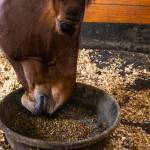The Importance of Protein During Convalescence

Formulating a diet for a horse with a musculoskeletal injury requires knowledge of protein use within the body. In the first part of this series, energy was addressed. (See “The Role of Energy in the Healing Process.”) The discussion is continued with this review of protein.
Although most adult athletic horses are overfed protein, both when they are working and when they are not, particular attention should be placed on protein and amino acid intake during recovery from injury. Low blood protein levels are an indicator of lower tissue protein levels, and these will impair several processes that are required for healing. This includes fibroplasia, the remodeling of connective tissue, as well as an increase in tensile strength after repair begins.
Researchers have shown experimentally that animals placed on high-protein diets have a more rapid gain in tensile strength with less edema formation than animals on protein-deficient diets. The adverse effects of a protein or energy shortage occur well in advance of the external evidence of weight loss, so dietary intakes of energy and protein should be reviewed immediately after injury. The horse can then be placed in a positive energy and protein balance rather than waiting for signs of a negative balance.
Even if the total quantity of crude protein is adequate, if the amino acids within the protein are not balanced, the horse may still suffer the effects of protein deprivation. The horse has 10 amino acids that must be supplied by the diet, while another 17 can be synthesised in the body. There is little information on the specific amino acid requirements of the horse and only a lysine requirement is published. Lysine is the first limiting amino acid for growth, and it is thought that threonine and methionine are the next most important. Methionine plays a particularly important role in the healing process, and it is involved in the production of cysteine, another amino acid. Cysteine is a collagen cofactor that is involved in cross-linking disulfide bonds that give strength to connective tissue.
Soybean meal, full-fat soybean meal, milk powder, and alfalfa (lucerne) have the best-quality protein among feeds commonly used with horses. Soybean meal has the highest lysine and threonine content, and overall has the best amino acid balance. Full-fat soybean meal retains its oil content so it has a lower total protein content and amino acid content, but the presence of the oil may be useful for adding energy to the diet. Milk powder is not commonly fed to adult horses, but it is a good source of essential amino acids. Alfalfa contains lower levels than many of the vegetable protein sources, but it is fed in such large quantities that its total contribution to amino acid intake is significant. Alfalfa hay or chaff should be used as the principal roughage source in feeding a horse that is recovering from injury.
In formulating a diet for the horse recovering from a musculoskeletal injury, consider not only exceeding the crude protein requirements but also the lysine requirement. It can be assumed that if high-quality protein sources are used for this purpose, then other amino acid requirements will be met as well. Special consideration could be given to the use of supplements that contain high levels of methionine as these may be valuable during convalescence.







